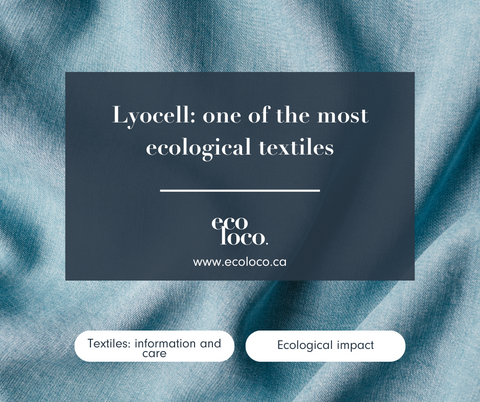
Today, we present to you one of our favorite textiles because it meets high ecological standards and also because it is resistant and so comfortable. This is a textile made from plant raw material coming from wood pulp. This pulp is transformed into an ecological synthetic fiber called Lyocell . Lyocell, also known under the registered name Tencel® by the Lenzing company. It is therefore an ecological synthetic fiber created by man from wood pulp!

Fabric characteristics
- Washes effectively in cold water
- Absorbs moisture and dyes well, retains its colors afterwards
- Soft and light like silk
- As durable as polyester
- Adapts to body temperature like wool.
- Don't lint.
How is it ecological?
The cultivation of raw materials:

The wood pulp used for its manufacture comes from certified sustainable and renewable forests and the trees are grown specifically for its production: pine, beech and especially eucalyptus. By sustainable forests, it is understood that the trees are grown without insecticides and pesticides, that they grow with little water and on land not suitable for agriculture. In addition to coming from renewable and sustainable materials, the production of Lyocell results in minimal environmental impacts that we will look at together.
Transformation into fiber:
The transformation of bamboo and eucalyptus into textile fiber follows a comparable procedure. However, the solvent used (NMMO or N-Methylmorpholine N-oxide) for Lyocell, in addition to being an organic compound that has not undergone any chemical transformation, is a non-toxic and biodegradable product. This therefore suggests that it is neither harmful to humans nor to the environment. Bingo!
Closed production loop:
The textile material is produced in a manufacturing system called closed loop. This means that all resources used are recycled, purified and reused continuously. The wood pulp is therefore dissolved in a non-toxic and non-corrosive solvent which is reused from 99.5% to 99.8%! Not only is this the case for solvents but this same result is obtained with water used in processing and to dye textiles. It's fantastic !
Bleaching and dyeing:

Among the advantages of Lyocell, since it is already clean and pure, this fiber does not need to be bleached. Additionally, as it is a highly absorbent fiber, it absorbs and retains dyes well. This allows for a reduction in energy and water requirements at the coloring stage.
Textile mix:
Unlike rayon from bamboo, Lyocell does not need to be mixed with cotton or other textiles to produce a good quality fabric that does not shrink when washed. In most cases, the compromise will come from the fact that it is regularly mixed in small amounts with spandex to make it even more durable and increase its flexibility and comfort.
Quick comparisons:

The comparison with cotton seems futile to us since the latter requires much more water, pesticides and agricultural land (10 times more than Lyocell). On the other hand, Lyocell is very similar to bamboo rayon both from the point of view of the cultivation of the raw material and the quality of the textile. The difference is mainly at the level of the solvent, that of bamboo being chemical and toxic.
So what ?
Given the same number of sweaters, it is clear to us that we choose the one made from Lyocell! We believe that this is a textile that is both innovative and ensures a better future. However, unfortunately it is still a textile used rather marginally and we consider that we would benefit from using it to replace cotton. At the moment, Eco Loco has some clothes made with this textile. You will find them by clicking here .














0 comments